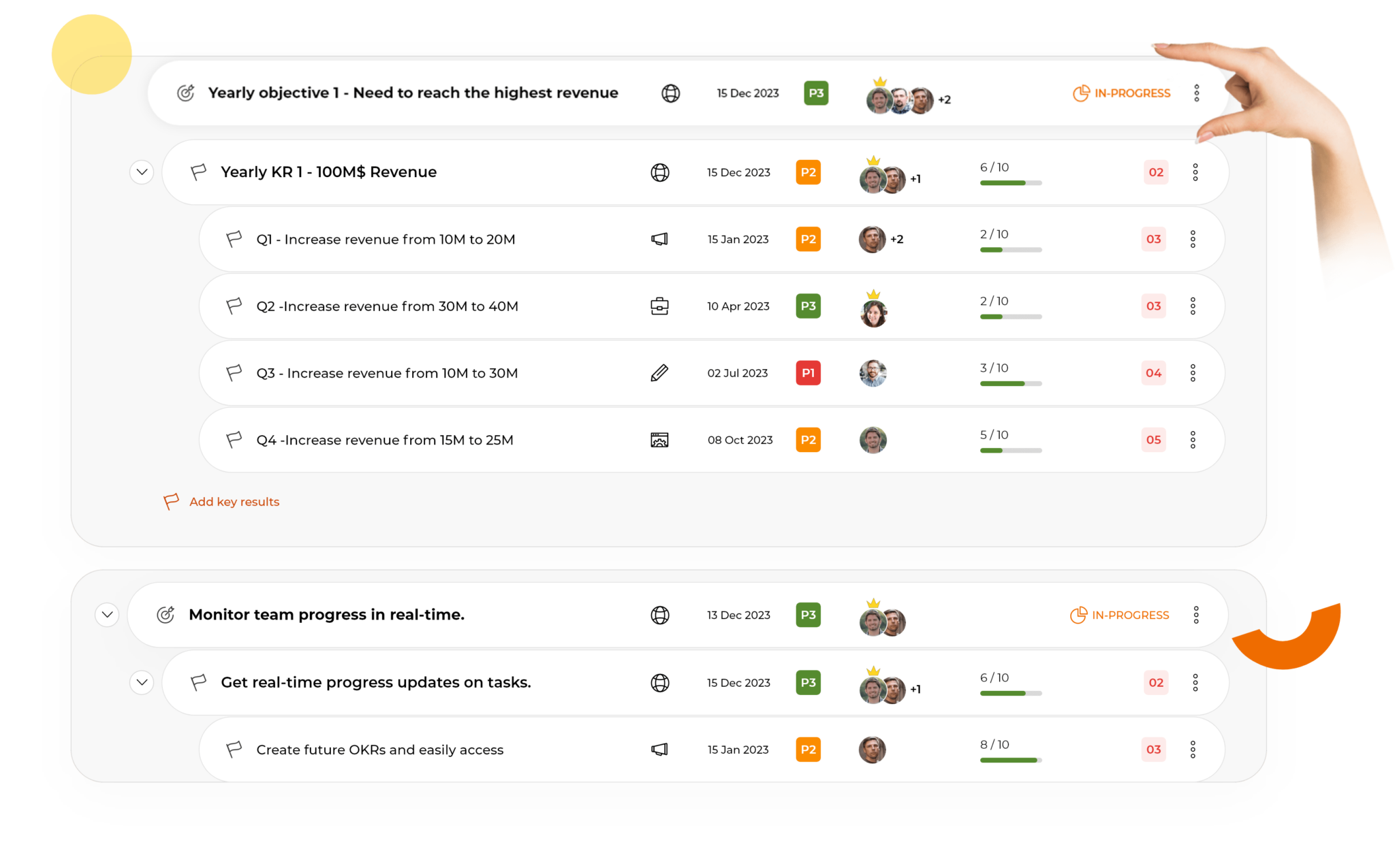Do you often find yourself struggling to meet deadlines or feeling overwhelmed with your workload? If so, then OKRs (Objectives and Key Results) might just be the solution for you! In this blog post, we’ll share our top tips and strategies on how to use OKRs to increase productivity by 10x.
Whether you’re a business owner, manager, or individual contributor, these actionable insights will help you set meaningful goals, track progress effectively, and achieve better results faster than ever before. So, let’s dive in and explore the power of OKRs together!
Setting Goals with OKRs
Here are some tips and strategies:
Define what you want to achieve
The first step to set goals is to define what you want to achieve. When it comes to setting OKRs, this means being clear about the overall objectives you’re trying to accomplish and the key results that will contribute to those objectives.
Involve your team
Once you know what you want to achieve, involve your team in the goal-setting process. Brainstorm together and come up with specific, measurable, achievable, relevant, and time-bound goals that everyone can buy into.
Set realistic goals
It’s important to set realistic goals that challenge your team but are still achievable. There’s no point in setting goals that are impossible to reach or that don’t contribute to your overall objectives.
Make sure your goals are aligned
All your team’s goals should be aligned with each other and with the overall objectives of the company. This ensures that everyone is working towards the same thing and that all your efforts are focused on the right direction.
Track progress and revise as needed
As you work towards your OKRs, track progress carefully and revise as needed. This helps ensure that you stay on track and makes it easier to course correct if necessary.
Creating an Effective Workflow System for OKRs
OKRs provide a framework that can be customized to fit the needs of any organization. An effective workflow system for OKRs begins with setting clear objectives. These objectives should be in the SMART model. Once the objectives have been set, key results need to be identified. These key results should help track progress and ensure that the objectives are being met.
The next step is to create a timeline for each objective and key result. This timeline will help keep everyone on track and ensure that the work is done in a timely manner. It is important to assign responsibility for each task and milestone. With a clear workflow system in place, organizations can achieve their goals and objectives more efficiently and effectively.
Measuring Progress and Outcomes with OKRs
The best way to measure progress and outcomes with OKRs is to use a combination of qualitative and quantitative data. Qualitative data can be collected through surveys, interviews, focus groups, and other methods. This type of data can help you understand how well your employees are meeting their goals and how they feel about the overall process.
Quantitative data, on the other hand, can be collected through performance tracking systems, sales data, financial data, and other sources. This type of data can help you measure progress more objectively and identify areas that need improvement.
Overcoming Obstacles When Working with OKRs
Working with OKRs can be a powerful framework for setting goals within an organization. However, like any goal-setting system, there can be challenges and obstacles that need to be overcome to ensure success. Here are some common obstacles when working with OKRs and strategies for overcoming them:
Lack of alignment
One of the key challenges in implementing OKRs is ensuring alignment between individual goals and the broader organizational objectives. To overcome this, start by clearly communicating the strategic objectives to all teams and individuals. Regularly review and cascade the objectives down the hierarchy, ensuring that everyone understands how their work contributes to the overall goals.
Unrealistic or unclear objectives
Setting unrealistic or vague objectives can lead to frustration and a lack of motivation. Ensure that objectives are SMART. Collaborate with teams to set challenging but attainable goals that inspire them to strive for excellence.
Poor prioritization
Sometimes, teams may have too many objectives, leading to a lack of focus and diluted efforts. Encourage teams to prioritize their objectives and focus on a smaller set of key results that have the most impact. This requires ongoing evaluation and ruthless prioritization to ensure that resources are allocated effectively.
Inadequate communication
Effective communication is crucial for successful OKR implementation. Lack of communication can lead to misunderstandings, duplication of efforts, and misalignment. Establish clear communication channels and cadences for sharing progress, challenges, and updates related to OKRs. Regularly provide feedback, recognize achievements, and address any roadblocks that teams may encounter.
Fear of failure
If teams fear the consequences of failing to achieve an objective, they may set conservative goals or avoid taking risks. Create a psychologically safe environment where failure is viewed as an opportunity for learning and growth. Encourage experimentation and innovation and celebrate both successes and failures as valuable sources of knowledge.
Lack of accountability
Holding teams accountable for their OKRs is essential to drive progress. Establish a system where teams regularly track and report their key results. Encourage transparency and provide support when teams encounter difficulties. Ensure that there are consequences for consistently failing to meet objectives, while also recognizing and rewarding achievements.
Lack of adaptability
Circumstances and priorities can change, requiring adjustments to OKRs. Be prepared to revisit and update objectives throughout the OKR cycle. Foster a culture of adaptability and agility, allowing teams to realign their goals and key results based on emerging opportunities or challenges.
Conclusion
We hope that this article has been useful in introducing you to 10x productivity and the OKR system. Through utilizing this system, teams can enjoy increased collaboration and communication, as well as an improved focus on key objectives. When used properly, OKRs have proven to be a great tool for any organization looking to increase their output at a rapid pace. With the right strategies in place, organizations are sure to reach their goals and enjoy ample success along the way!
Visit Our Social Profile to know More Better About OKRs
Contents




 for growth seeking organizations.
for growth seeking organizations.
Comments are closed